Sum of n Terms of an Arithmetic Progression
We know what an arithmetic progression (A.P.) is. Sometimes, we may come across the situations when we have to find the sum of all terms involved in a series and if the series is an AP, then there is a formula which can make the process very simple.
Let us consider a similar situation.
Harry saved Rs 2000 from his salary in the first month. He increases his savings by Rs 50 every month.
Can we calculate his total savings for the first four months?
Let us try to find it.
To find the total savings for the first 4 months, we have to take the sum of the savings for the first four months.
It is given that, savings of Harry for the first month = Rs 2000
Every month, he increases his savings by Rs 50.
Thus, savings for second month = Rs (2000 + 50) = Rs 2050
Similarly, savings for the third month = Rs (2050 + 50) = Rs 2100 nd,
savings for the fourth month = Rs (2100 + 50) = Rs 2150
Thus, the total savings of Harry for the first four months = Rs (2000 + 2050 + 2100 + 2150)
= Rs 8300
Now, can we calculate the total savings of Harry for 2 years?
Yes, we can find it as above but it is a very lengthy as well as time consuming process as we have to find the savings for 24 months.
We can also find the total savings of Harry for first two years using a formula. Now, let us see how we can find it.
The savings of Harry for each month forms an A.P., which is as follows. 2000, 2050, 2100, 2150 ….
The sum of savings of Harry = Rs (2000 + 2050 + 2100 + 2150 ….)
Here, we can observe that the total savings of Harry for the first month is the first term of the A.P., i.e. Rs 2000. The total savings for the first two months is the sum of first two terms of the A.P., i.e. Rs (2000 + 2050). In the same way, the total savings of Harry for first 2 years, i.e. 24 months, is the sum of first 24 terms of the A.P. We can find it by using the formula for finding the sum of n terms of an A.P.
Now, let us find the sum of first 24 terms of the above discussed A.P. which is as follows: 2000, 2050, 2100, 2150 ….
Here, first term, a = 2000
Common difference, d = 2050 − 2000 = 50
The sum of first 24 terms of the A.P. is
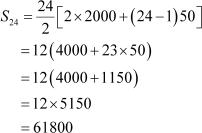
Therefore, the total savings of Harry for the first two years is Rs 61800.
This formula is used when we are given the first term and the common difference of the arithmetic progression.
We can also find the sum of n terms of an A.P., if we know the first and the last term.
The sum of n terms of an A.P. whose first term is a and last term is l is given by the formula:

For example, consider an A.P. whose first term is 2 and 30th term is 263. Then, what will be the sum of 30 terms?
Here, a = 2, l = 263 and n = 30
Therefore, sum of 30 terms

= 15 × 265
= 3975
Thus, the sum of 30 terms is 3975.
Result: The sum of the first n natural numbers is given by  .
.
Proof:
This can be proved by two methods.
1st method (Using concept of A.P.):
The first n natural numbers can be listed as 1, 2, 3, …, n.
Here, a = 1, d = 1.

2nd method (Without using concept of A.P.):
Sn = 1 + 2 + 3 + … + n … (1)
Sn = n + (n – 1) + (n – 2) + … + 3 + 2 + 1 … (2)
Adding (1) and (2):
2Sn = (n + 1) + (n + 1) + …… + (n + 1)
Here, there are n terms in the RHS.

Now, let us discuss some more examples based on sum of n terms of an A.P.
Example 1: Find the sum of first 25 terms of the following A.P. 2, 7, 12 …
Solution:
Here, a = 2 and d = 7 − 2 = 5.
Sum of the first 25 terms is given by
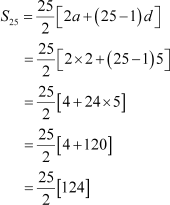
= 25 × 62
= 1550
Thus, the sum of first 25 terms of the given A.P. is 1550.
Example 2: Find the sum of first 8 terms of the A.P whosenthterm is given by 6n − 5.
Solution:
The nth term is given by
an = 6n − 5
On replacing n by 1, 2, 3 … respectively, we get the first, second, third … terms of the A.P.
∴ a1 = 6(1) − 5 = 1
a2 = 6(2) − 5 = 7
a3 = 6(3) − 5 = 13 … and so on.
The A.P. so obtained is as follows.
1, 7, 13 …
Here, the first term, a = 1
and the common difference d = a2 − a1 = 7 − 1 = 6
Using the formula, ,  the sum of first 8 terms is given by
the sum of first 8 terms is given by
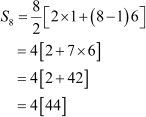
= 176
Thus, the sum of first 8 terms is 176.
Example 3: How many terms of the A.P. −28, −24, −20 … should be taken so that the sum will be zero?
Solution:
Let the sum of n terms be zero.
Here, a = − 28 and d = − 24 − (−28) = 4
Sum of n terms of an A.P. is given by

But, it is given that the sum of n terms of the given A.P. is zero.
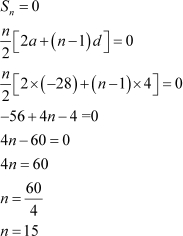
Thus, the sum of 15 terms of the A.P is zero.
Example 4: Sapna’s father planted 4 trees in his garden, when he was 22 years old. After that, every year he planted one more tree than the number of trees he planted in the previous year. How many trees will be there in his garden when he will become 40 years old?
Solution:
We can write the given information in the form of an A.P. as follows
Number of trees he planted in the first year = 4
Number of trees he planted in the second year = 4 + 1 = 5
Number of trees he planted in the third year = 5 + 1 = 6
And so on.
Now, the A.P. is 4, 5, 6 …
He planted trees from the age of 22 years to 40 years, i.e. for 19 years.
Thus, we have to find the sum of 19 terms of this A.P.
Here, a = 4, d = 1
And, n = 19
Using the formula, ,  the sum of 19 terms of this A.P. is given by
the sum of 19 terms of this A.P. is given by
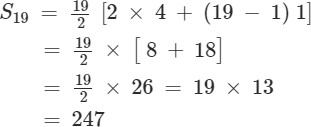
Thus, there will be 247 trees in his garden when he will become 40 years old.
Example 5: The  term of an A.P. is q and the
term of an A.P. is q and the  term of the A.P. is p. What is the sum of (p + q) terms of the A.P.?
term of the A.P. is p. What is the sum of (p + q) terms of the A.P.?
Solution:
Let the first term and the common difference of the A.P. be a and d respectively.
It is given that the  term is q.
term is q.
∴ ap = q
⇒ a + (p − 1) d = q … (1)
Similarly, the qth term is p, therefore we obtain
a + (q − 1) d = p … (2)
On subtracting equation (1) from (2), we obtain
p − q = (q − 1) d − (p − 1) d
p − q = d [q − 1 − p + 1]

By putting the value of d in equation (1), we obtain
q = a + (p − 1) (−1)
q = a + 1 − p
a = p + q − 1
But we know that the sum of n terms of an A.P. is

Thus, the sum of (p + q) terms is
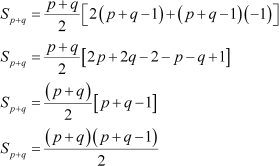
Thus, the sum of (p + q) terms is .
Example 6: Find the nth term of the A.P., the sum of whose n terms is n2 + 2n.
Solution:
Let Sn be the sum of n terms.
It is given that the sum of n terms of the A.P. is n2 + 2n.
∴ Sn = n2 + 2n … (1)
On replacing n by (n − 1) in the equation, we obtain

Let an be the nth term of the A.P. Therefore, we can write
Sn = Sn−1 + an
Thus, an = Sn − Sn−1
= n2 + 2n − [(n − 1)2 + 2(n − 1)]
= n2 + 2n − [n2 + 1 − 2n + 2n − 2]
= n2 + 2n − n2 + 1
= 2n + 1
Thus, the nth term of the A.P is (2n + 1).
Example 7: Find the sum of first 1000 natural numbers.
Solution:
The sum of first n natural number is given by  .
.

Hence, the sum of first 1000 natural numbers is 500500.
Example 8: If sum of the first n natural numbers is 5050, find the value of n.
Solution:
The sum of first n natural number is given by  . Now,
. Now,
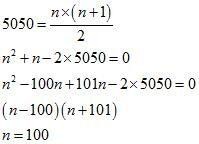
Hence, n = 100
Properties of Arithmetic Progressions and the Concept of Arithmetic Mean
Arithmetic progression is a sequence of numbers such that the difference between the consecutive terms is a constant. It exhibits some properties which are used in solving various problems.
Properties of an Arithmetic Progression
- If a constant is added to each term of an A.P., the resulting sequence will also be an A.P.
- If a constant is subtracted from each term of an A.P., the resulting sequence will also be an A.P.
- If a constant is multiplied to each term of an A.P., the resulting sequence will also be an A.P.
- If each term of an A.P. is divided by a non-zero constant, the resulting sequence is also an A.P.
Arithmetic Mean
If we are given two numbers a and b, then we can insert a number A between these two numbers so that the sequence a, A, b becomes an A.P. Such a number i.e., A is called an arithmetic mean (A.M.) of the numbers a and b.
If A is the A.M. of the numbers a and b, then A is given by A =  .
.
For example, the A.M. of the two numbers 18 and 16 is  .
.
For any two given numbers a and b, we can insert as many numbers between them as we want such that the resulting sequence becomes an A.P.
Example 1: Between −12 and 40, p numbers have been inserted in such a way that the resulting sequence is an A.P. Find the value of p if the ratio of the 4th and the (p −
3)th number is 1 : 6.
Solution:
Let A1, A2, … Ap be p numbers such that −12, A1, A2, … Ap, 40 is an A.P.
Here, a = −12, b = 40, n = p + 2
∴ 40 = −12 + (p + 2 − 1) (d)
⇒ 52 = (p + 1) d

A1 = a + d
A2 = a + 2d
A3 = a + 3d …
∴ A4 = a + 4d
Ap−3 = a + (p − 3) d
According to the given information,
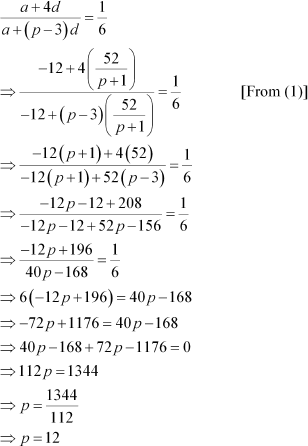
Thus, the value of p is 12.
Example 2: Between 10 and 30, m numbers are inserted such that the resulting sequence is an A.P. If the sum of all the terms of the A.P. is 140, then find the value of m.
Solution:
It is given that between 10 and 30, m numbers are inserted such that the resulting sequence is an A.P.
It is also given that the sum of all the terms in the A.P. is 140.
We know that the sum of n terms of an A.P. is given by
 , where a is the first term and l is the last term
, where a is the first term and l is the last term
Here, a = 10, l = 30
Therefore,
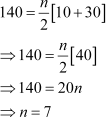
Thus, the total number of terms in the A.P. is 7.
Thus, the value of m is 7 − 2 = 5.

 SonikaAnandAcademy
SonikaAnandAcademy
 ACERISE INDIA
ACERISE INDIA
